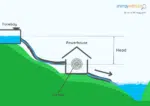If you’ve heard of microhydro systems, you may be wondering how they work and if they’re worth pursuing as a means of using renewable energy around your home or for small businesses. Our information below will help shed some light on what these systems are, how they work, and if they’re worth it. For many rural and remote locations, a microhydro system can often be more reliable than the main electrical grid as it can directly power homes at a closer range and have stronger output.
What is a microhydro system?
A microhydro system is a power system that converts the potential energy in small streams and waterways into kinetic energy via a mechanical turbine, which drives a generator to produce electricity. The greater the quantity of water and drop there is flowing through the turbine, the more electricity can be generated. It is one of the most reliable and consistent sources of renewable energy available if there is a good water resource with year-round flow and several feet of elevation drop. It can provide years of continuous power.
Most microhydro hardware manufacturers state that most set-ups have a life of 25 years, but the same manufacturers have many turbines out in fields that have lasted well over 50 years old and still work reliably and efficiently. It will depend on many factors of course, such as set-up, landscape, weather, and maintenance.
How does it work?
In essence, a microhydro system works by using turbines, pumps, or waterwheels to transform flowing water into rotational energy. The generator or alternator will turn that rotational energy into electricity that will get delivered to where you need it via wires, much like regular powerlines. The intake of water comes from streams or rivers you may be living next to or have business near that will reach where you need it to be.

Commercially available generators and turbines are usually sold as a package together. There are do-it-yourself options available for the system, but you do need to be careful matching a generator with the turbine horsepower and speed without anything causing issues. Many systems use an inverter to convert the low-voltage direct current electricity produced by the system into volts, AC energy. It is advised to have professionals consult, install, and follow up with you to set up a microhydro system – especially if it is your first time doing so and have no prior electrical knowledge, for safety, efficiency, and cost-related reasons.
How much does it cost to get set up and installed?
Getting a microhydro system started can cost anywhere from $2,000 or less upwards to $20,000+, depending on the size needed, the location and environmental landscape, and the equipment decided on to ensure a smooth and durable environment. It will first and foremost always depend on your current landscape and what is possible with the water flow you currently have, as that is the most important part of starting a microhydro system.
A small stream can work very well, though it may need to be diverted and changed more than anticipated, and the environmental impacts will need to be thought through as well. They are minimal, but if your location is not quite ideal, it can cause more harm than a stronger current river or stream may be able to produce.
Are microhydro systems worth it?
The pros and cons of utilizing a microhydro system are like many kinds of renewable energy sources, which depends on where you are living, the landscape, the seasonal weather changes and patterns, and your budget as well. Small-scale microhydro power is both a reliable and efficient form of energy most of the year, but there are also disadvantages that come with it.
Pros:
- Reliable and efficient energy source
- It requires a small amount of flow (as little as two gallons per minute in some cases) or a drop as low as two feet to generate electricity using a microhydro set-up. Electricity can be delivered and used as far as nearly two kilometres away from the location it is running from.
- Peak energy season is in winter when large quantities of electricity are needed more often with less sunlight and less heat needing to be supplemented. Hydro provides a continuous supply of electrical energy compared to other smaller-scale renewable technologies.
- No reservoir or large-scale set-up is required
- Microhydro is considered a “run-of-river” system, meaning that the water passing through the generator is directed back into the stream with relatively little impact on the surrounding environment and landscape.
- Depending on the landscape you already have around you, it may take less set-up and be more efficient without disturbing the area like you may need to for other areas.
- Cost-effectiveness
- Building a small-scale energy set-up like a microhydro system can cost anywhere from around $1,000 upwards to $20,000+ depending on the site electricity requirements and location. The maintenance fees are also relatively lo in comparison to other technologies and green energy systems, since it is relatively self-sustaining.
- Integration with the local grid
- If you have a large area and a larger system that is generating excess energy, some power companies may even ask to buy back your electricity overflow. There is also the ability to supplement your level of microhydro power with intake from the power grid like normal, which is especially helpful in the summer or in other seasons when your electrical flow may be lower.
Cons:
- Suitable site characteristics and locations required
- To get the full advantage of a microhydro system and get full electrical potential with small streams, a suitable location and site is needed. Distance from the power source to where the electricity will be used, stream size including flow rate, drop, and output, and a balance of system components need to be factored in. Pipelines, inverters, batteries, and transmission lines to name a few to keep in mind.
- Energy expansion may not be possible
- Depending on the site and location your system is located, the size and flow of small streams may restrict future site expansion as power demand increases may not be possible.
- Summer months may provide less flow than expected
- In many locations the stream size will fluctuate based on the season and weather. During the summer months, in particular, there will likely be less flow and that means less power output for use. Planning in advance and keeping the changing seasons in mind and how the area you’re looking to install a system can help ensure that adequate energy requirements will be met all year round.
- Environmental impacts are still a factor
- The environmental and ecological impact of small-scale systems such as microhydro is minimal, especially compared to other options, but the lasting environmental effects should be considered before construction begins. Stream water will be moved and directed away, and caution must be taken to ensure that there will be no damage to the local ecology or civil infrastructure.
Myths related to microhydropower systems
There are also many myths in regard to microhydro systems out there when looking up information, and to address some of those as well in a concise manner:
Small streams do not provide enough energy to generate power
Untrue, as energy output depends on the stream flow itself, and how much water flows through the system, and the vertical distance the water will fall through the turbine itself (known as drop) This requires much less water and drop than most expect it to need, especially with how technology and systems have updated over the years.
Along with that topic, a large reservoir of water being required is also untrue. Most small-scale microhydro systems require very little or no reservoir at all in order to power the turbines. Run-of-river style, meaning the water will run straight through the generator and back into the stream, resulting in a minimal environmental impact, working with the local ecosystem.
Microhydro electricity is unreliable and low quality
Technology advances, especially maintenance-free water intake equipment and solid-state electrical equipment ensure that these systems are more reliable and efficient in remote and rural areas. They can be more reliable than the power grid for many. As for low-quality electricity claims – when using the latest electronic control equipment, converters, inverters, and alternators are being used and maintained with a proper set-up in the first place, it has the potential to be even greater than the main electrical power grid.
Using a microhydro system isn’t free and can be cost-intensive to build and maintain. It can also save money in the long run and for those living remotely or rurally who have frequent issues with electricity on the main power grid or just want to use cleaner energy, a microhydro system is worth looking into and determining whether it is worth it yourself.











